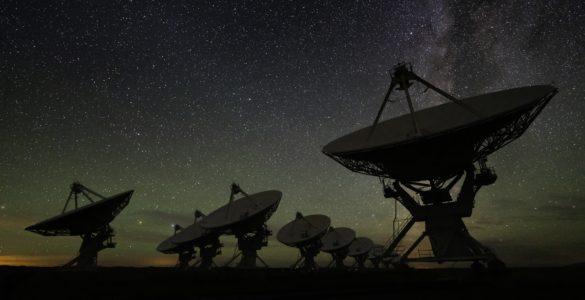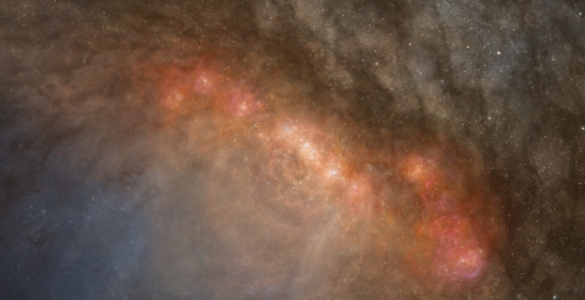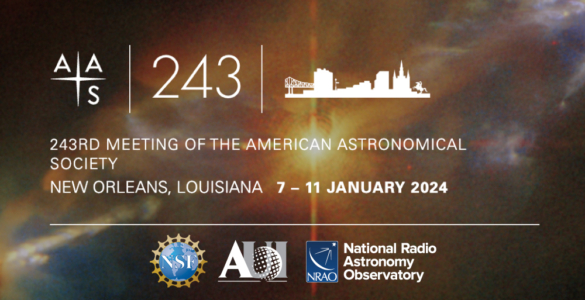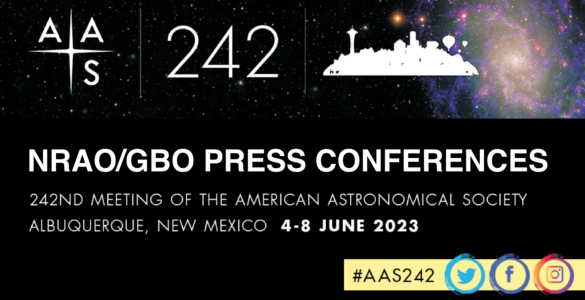Researchers using the Very Large Array (VLA) have discovered that a small, powerful object in our own cosmic neighborhood is shooting out material at nearly the speed of light — a feat previously known to be performed only by the massive cores of entire galaxies. In fact, because of the direction in which the material is moving, it appears to be traveling faster than the speed of light — a phenomenon called “superluminal motion.” This is the first superluminal motion ever detected within our Galaxy.
During March and April of this year, Dr. Felix Mirabel of the Astrophysics Section of the Center for Studies at Saclay, France, and Dr. Luis Rodriguez of the Institute of Astronomy at the National Autonomous University in Mexico City and NRAO, observed “a remarkable ejection event” in which the object shot out material in opposite directions at 92 percent of the speed of light, or more than 171,000 miles per second. This event ejected a mass equal to one-third that of the moon with the power of 100 million suns.
Such powerful ejections are well known in distant galaxies and quasars, millions and billions of light-years away, but the object Mirabel and Rodriguez observed is within our own Milky Way Galaxy, only 40,000 light-years away. The object also is much smaller and less massive than the core of a galaxy, so the scientists were quite surprised to find it capable of accelerating material to such speeds.
Mirabel and Rodriguez believe that the object is likely a double-star system, with one of the stars either an extremely dense neutron star or a black hole. The neutron star or black hole is the central object of the system, with great mass and strong gravitational pull. It is surrounded by a disk of material orbiting closely and being drawn into it. Such a disk is known as an accretion disk. The central object’s powerful gravity, they believe, is pulling material from a more-normal companion star into the accretion disk. The central object is emitting jets of subatomic particles from its poles, and it is in these jets that the rapidly-moving material was tracked.
The object, known as GRS 1915+105, also is a strong emitter of X-Rays, sometimes becoming the strongest source of X-Rays in the Milky Way. The X-rays, they think, are emitted from the system’s accretion disk. The VLA observations, along with other evidence the researchers have uncovered, leads them to believe that, despite being much less massive than galactic cores, other double-star systems may be capable of ejecting material at speeds near that of light. The researchers reported their discovery in the September 1 issue of the journal Nature.
“This discovery is one of the most valuable results of more than a decade and a half of observations at the VLA,” said Dr. Miller Goss, assistant director of NRAO for VLA/VLBA operations. “We see these fast-moving jets of material throughout the universe, and they represent an important physical process. However, they’re usually so far away that it’s difficult to study them. This object, relatively nearby, offers the best opportunity yet to build a good understanding of how such jets actually work,” Goss added.
GRS 1915+105 was discovered in 1992 by an orbiting French- Russian X-ray observatory called SIGMA-GRANAT. It had not been found before because its X-rays are highly-energetic “hard” X-rays not regularly observed by satellites before then. Since its discovery, it has repeatedly been seen as a source of “hard” X- rays. Despite searching, the scientists have been unable to observe the object in visible light. Observations with the VLA in 1992 and 1993 showed that the object changed both its radio “brightness” and its apparent position in the sky, but it was then too faint at radio wavelengths for precise measurements. In March of 1994, the object began an outburst of strong radio emission just as the VLA had entered a configuration capable of its most precise positional measurements. Through March and April of 1994, Mirabel and Rodriguez were able to track the movement of the two condensations in the jets of material moving away from the object’s core.
They found that the core remained stationary, while the approaching condensation was apparently moving at 125 percent of the speed of light. After correcting for relativistic effects, they conclude that the ejected material actually is moving at 92 percent of light speed. Their calculations indicate that the pair of “blobs” they tracked were ejected from the core on March 19, during a period when the object was emitting more X-rays than usual.
GRS 1915+105 somewhat resembles a famous astronomical object that was intensively studied in the late 1970s and early 1980s, called SS433. The VLA was used for many observations of SS433, which, astronomers believe, is also a double-star system with a dense, massive star as its centerpiece. SS433 has jets similar to those of GRS 1915+105, but the fastest motions detected in SS433’s jets are only 26 percent the speed of light. Comparing it to quasars, which are believed to be phenomena associated with supermassive black holes at the centers of galaxies — objects much larger and more massive than stars — astronomers have called SS433 a “stellar microquasar.” With kinetic energies 40 times those of SS433, GRS 1915+105 “appears to be a scaled up version” of the other object, Mirabel and Rodriguez say.
The National Radio Astronomy Observatory is a facility of the National Science Foundation,
operated under cooperative agreement by Associated Universities, Inc.
Contact:
Dave Finley
(505) 835-7302















